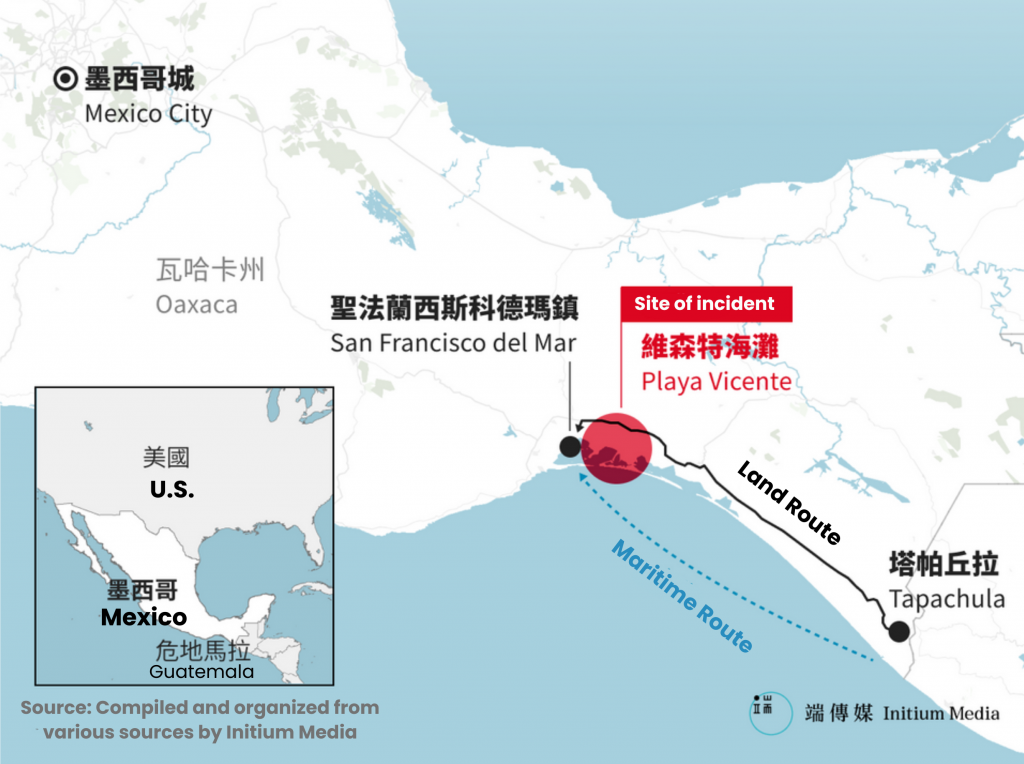This article was originally published in Chinese in The Initium Media, an independent media organization serving the global Chinese-speaking community with comprehensive and independent news coverage. The article is translated by April Xu at Documented.
On March 29th, the “Good Friday” before Easter, many Mexicans gathered with their families and attended prayers at churches. However, tragic news emerged from the eastern coast of the state of Oaxaca, where local fishermen discovered eight bodies washed ashore at a beach in the town of Playa Vicente.
Without any life jackets, the victims wore only sportswear, lying on the shallow beach where waves relentlessly crashed. Some had their clothes flipped over their heads, leaving them exposed. Their aspirations for the “American Dream” ended tragically amidst the turbulent waves of Playa Vicente. A middle-aged man in a pink polo shirt, drenched and sorrowful, was seen crying nearby.
Interviewed by local journalist Jose Ignacio, the man confirmed that he and the victims were all Chinese migrants attempting to cross the border. Under the guidance of Mexican boatmen, they embarked from Tapachula, a southern border city of Mexico, intending to reach Oaxaca, and then continue northward by land to enter the United States. However, their vessel capsized near Playa Vicente, and everyone except him perished, including his wife and son. He managed to survive by clinging onto a floating suitcase.
This is the first publicly known maritime tragedy involving a big group of Chinese migrants in Mexico. Initium Media discovered the identities of some of the deceased, and it interviewed Chinese migrant Sam, who took the same maritime route before and currently resides in New York City.
The survivor, Zhongjin Huang, is a 50-year-old man who is originally from Fujian Province in China. According to Oaxaca’s prosecutor’s office, the bodies found on the beach were all Chinese citizens, including seven females and one male. Only Huang survived, while the whereabouts of the Mexican crew remain unknown. Authorities confirmed to Initium Media that Huang is in good physical condition, with only minor injuries. He is currently under witness protection by the Mexican immigration authorities and is cooperating with the investigation, still stranded in Oaxaca.
Among the eight Chinese victims, the identities of three female victims remain unconfirmed. The names of the other five are Yanjie Liu (female), Julun Xiao (female), Hongxin Cheng (female), Xiuying Huang (male), and Fengrong Mu (female). As of the publication of this article, the bodies of the victims have not been claimed.
Zhongjin Huang is in touch with Alejandro Solalinde, a renowned immigrant rights defender and Catholic priest in Mexico, while awaiting further legal proceedings. Solalinde primarily provides humanitarian assistance to immigrants traveling from Central and South America to the United States.
Local prosecutors announced that they are investigating the cause of the accident, preliminarily attributing it to strong winds. Authorities are collaborating with the Chinese Embassy in Mexico to confirm the identities of the victims.
During a routine press conference on April 1st, Chinese Foreign Ministry spokesperson Wenbin Wang stated that China is closely monitoring the capsizing incident, maintaining close communication with Mexico, further verifying the information of the deceased, and providing assistance to surviving Chinese citizens.
According to local media, just two months before this maritime tragedy, a vessel carrying approximately 20 Central American migrants capsized in the same area, but there were no fatalities.
The speedboat of death
In the migrants’ group chats, it is widely acknowledged that there are many police checkpoints intercepting migrants along the land route from Tapachula, so despite knowing the risks of the water route, they still took the chance.
Local informants told the Initium Media that the area is prone to strong winds, and in recent years there have been several incidents of boats capsizing due to these winds. The small boats carrying migrants are typically not sturdy enough, making it extremely unsafe to venture out to sea during windy conditions.
“We (Chinese migrants) call this boat the ‘speedboat of death,'” said Sam, a 44-year-old Chinese migrant from Henan, who traversed this stretch of water in February last year and now resides in New York. Sam declined to reveal his full name for privacy reasons. He and some other Chinese migrants shared their harrowing experiences on the journey and shed light on the complex human trafficking networks involving Chinese business people behind this tragedy in Mexico. Reflecting on it now, he still shudders: “I’ve never experienced anything so dangerous in my life, it was a close call.”
At the time, he and about 20 other Chinese migrants boarded a boat from Tapachula. They set sail as soon as it got dark, with their destination being the town of Arriaga in the eastern part of Oaxaca state. Twenty people crammed onto a small makeshift wooden speedboat, overcrowded to the point where there was barely any room to move legs. An hour into the journey, the boat broke down and had to turn back. After changing the engine, they set out again.
As they moved away from the coast, the winds and waves grew stronger, causing the speedboat to bounce up and down with the waves, seemingly on the verge of falling apart at any moment. Sam sat in the middle of the boat, considering it the safest spot onboard. Despite this, he still felt like his insides were being tossed around. “When the boat flew up and then came crashing down, it felt like my organs were sinking down with it, the force was as strong as pounding the ground with a pile driver,” recalled Sam.
The people at the back of the boat endured even harsher turbulence. “One person kept screaming, saying his body was falling apart. I helped him support himself for two hours, but I couldn’t hold on anymore.” For the remainder of the journey, Sam could only silently pray for a safe arrival.
“I never want to experience that again, it was too painful, I didn’t want to spend another minute there.”
Before boarding, Sam had already heard in the telegram group of Chinese migrants gathering that several Chinese had lost their lives on this route, with one incident occurring just a month before he boarded. However, Initium Media outlets couldn’t independently verify this information.
Everyone in the migrant group said that there are many police checkpoints on the land route from Tapachula, intercepting illegal immigrants. Knowing the risks of the water route, Sam still decided to take the chance. “I accepted the risk. It’s impossible to just sleep and you would wake up in the United States overnight,” Sam said.

Because they had heard of fatalities on this route before, Sam and his companions told the smugglers that they wouldn’t board without life jackets. However, after setting sail, they realized there was another deadly risk aside from drowning. Late at night, the temperature dropped sharply, and the cold wind was bone-chilling. “At that moment on the boat, I thought, I can swim, but if a shipwreck happens, I’ll die because it’s too cold, I’ll die from hypothermia.”
Speaking about the news of the eight Chinese people who perished at sea in Mexico, Sam expressed his grief, “Many people are unaware of their deaths.” He wanted to know their names, hometowns, reasons for the accident, and why these people boarded the boat. He recalled his most helpless moment on the boat, realizing that if he had died at that time, the outside world would probably never know his story.
“If it were Americans who died, it would definitely be different. But since they were Chinese, they died like grass.”
Oaxaca: Heaven and Hell
Eastern Oaxaca is a crucial route from the southern border of Mexico to the north. Local media cited government data from Oaxaca state that, 800 to 1200 immigrants from at least ten countries enter the state through the southern border of Mexico every day. Some travel on foot, others by truck, but the majority arrive by boat.
When the speedboat safely docked at dawn, Sam felt like he had arrived in paradise in eastern Oaxaca. “The scenery was incredibly beautiful, with the sea and sky blending into one, and many large birds circling above. I had never seen anything like it before.” He recalled scenes similar to the movie “Life of Pi”, where he, like the protagonist, had just survived a harrowing ordeal in the vast ocean. He later successfully reached the United States and now operates a translation company in New York.
According to statistics from the U.S. Customs and Border Protection, in 2023, more than 37,000 Chinese nationals illegally crossed the border into the United States through Mexico. Although the number is less than those from countries like Mexico, Guatemala, and Venezuela, Chinese migrants represent one of the fastest-growing migrant groups in recent years.
The International Rescue Committee observed that Mexico’s policies towards migrants have shifted in recent years. Instead of deporting migrants found in the country, authorities are now sending them further south. In other words, migrants in Mexico are caught in a cycle of going back and forth, like pawns in a board game, forced to retreat several steps once they are caught.
This was Sam’s experience in Mexico. He was arrested by immigration authorities twice, detained for several days, and then sent south. After being released, he continued northward to the United States.
Before arriving in Mexico, Sam was robbed at gunpoint in Colombia and traversed the rainforests of the Darien Gap at the Colombia-Panama border on foot. However, he said that leaving Tapachula by sea was the most dangerous part of his 40-day journey.
“This was much more dangerous than being robbed. Robbers want money, but this was a matter of life and death.”
Ari Sawyer, a researcher at Human Rights Watch, previously stated in an interview that while migrants traveling to the United States used to consider the Darien Gap in the rainforest the most difficult part of the journey, many now say that Mexico has become the biggest obstacle.
“Mexico is the new ‘rainforest’,” Sawyer said.
Some Chinese immigrants interviewed by Initium Media revealed that some Chinese restaurant owners in Mexico are also involved in human trafficking. Chonghao Xiao, one of the Chinese migrants who took a treacherous journey to the U.S., told Initium Media that a local lawyer in Mexico informed him that the maritime smuggling operations are controlled by local gangs. They charge $100 to $180 per person for the journey from Tapachula to Oaxaca and other places. Xiao recalled that the quote he received from a Chinese restaurant owner for the maritime journey was $300 to $500 per person, indicating a significant markup.
Sam, who once took a speedboat in Tapachula, said he saw previous experiences in the migrants’ group chat and traced them to a Chinese restaurant owner who arranged the speedboat for him. “It’s like a tourism route, where someone tells you where to go and who will take care of you.”
He believes that migrants should do their homework before embarking on the journey and assess the risks they can tolerate. “I won’t blame these Chinese restaurant owners,” Sam said. “I don’t think they are doing anything wrong. Natural disasters and accidents happen, it’s not their fault. They are saving people, bringing them to a land of freedom. I think they are helping people.”
Among the various routes taken by migrants to the United States, the journey through Mexico is the longest, spanning over 4,000 kilometers from Tapachula in the south to the U.S.-Mexico border in the north. According to the International Organization for Migration (IOM), the Mexico-U.S. border has the highest number of deaths among all land migration routes globally. In 2022, a total of 686 migrants died or went missing in the border region.
This is the translation of part of the story, click here to read the full article.















